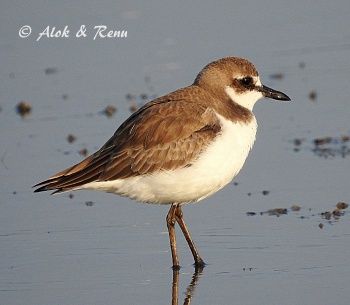
Photo © by Alok Tewari
Nazafgarh Marshes, Delhi-Gurgaon Border, India, May-2017
- Anarhynchus atrifrons
Charadrius atrifrons
Identification
18–21 cm (7-8¼ in)
- back brownish grey
- underparts white
- flanks clean, whitish
- legs dark
- bill black
Breeding
- breast, forehead and nape chestnut
- eye mask black
The female is similar but duller
Winter and juvenile birds lack the chestnut
Similar species
Siberian Sand Plover differ from Tibetan Sand Plover in:
- Siberian average larger, bill thicker and end blunter, legs shorter
- flanks are mottled in Siberian but clean in Tibetan
- in flight: feet protrudes past tail on Tibetan but usually not on Siberian
In breeding plumage
- Siberian male usually have some white above bill in the "bandits mask" while this is rare in Tibetan
- female Tibetan rarely have black in auricular area, something usually found in Siberian.
In non-breeding plumage
- breast band (nearly) unbroken on Siberian, but limited to breast sides in Tibetan
- pale forehead grades into the crown in Tibetan while demarcation is sharp in Siberian
Compare also with Greater Sand Plover
Distribution
Breeds from the Himalayas, on the west end north to Kyrgyzstan and south to northern India, and on the east end north to west-central China and Mongolia.
Winters along coasts or slightly inland in south Asia from Taiwan south to the Greater Sundas, west from there to the Red Sea and Africa south to Mozambique.
Vagrants have been recorded in Europe and Australia.

Photo © by Alok Tewari
Jamnagar, Coastal Gujarat, India, Jan-2016
Taxonomy
This species and Siberian Sand Plover were formerly lumped under the name of Lesser Sand Plover (sometimes instead named Mongolian (Sand) Plover).
Subspecies
Clements recognizes these subspecies[1]:
- A. a. pamirensis: Pamirs to western China (western Xinjiang); winters to Africa and western India
- A. a. atrifrons Himalayas and southern Tibet: winters from India to Sumatra
- A. a. schaeferi: Eastern Tibet to southern Mongolia; winters Thailand to Greater Sundas
Habitat
Breeds at high elevation, above the tree line, usually in dry areas that are near temporary water sources. During migration and winter, their habitat is similar to what would be expected for other plovers.
Behaviour
Strongly migratory, however, birds in their second calendar year may stay in the wintering grounds.
Vocalisation
References
- Clements, J. F., P. C. Rasmussen, T. S. Schulenberg, M. J. Iliff, T. A. Fredericks, J. A. Gerbracht, D. Lepage, A. Spencer, S. M. Billerman, B. L. Sullivan, and C. L. Wood. 2023. The eBird/Clements checklist of Birds of the World: v2023. Downloaded from https://www.birds.cornell.edu/clementschecklist/download/
- Gill, F, D Donsker, and P Rasmussen (Eds). 2024. IOC World Bird List (v 14.1). Doi 10.14344/IOC.ML.14.1. http://www.worldbirdnames.org/
Recommended Citation
- BirdForum Opus contributors. (2024) Tibetan Sand Plover. In: BirdForum, the forum for wild birds and birding. Retrieved 28 April 2024 from https://www.birdforum.net/opus/Tibetan_Sand_Plover
External Links
GSearch checked for 2020 platform.1



